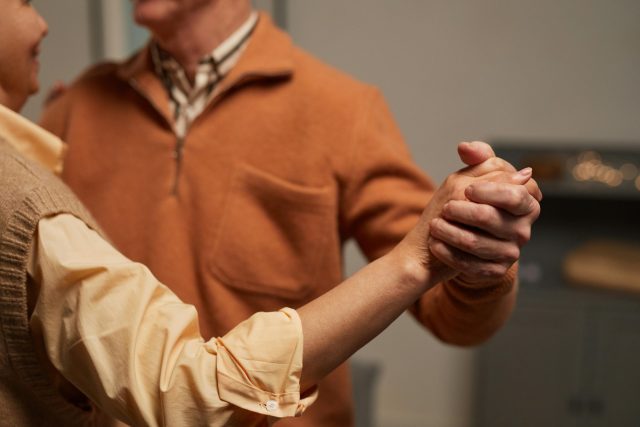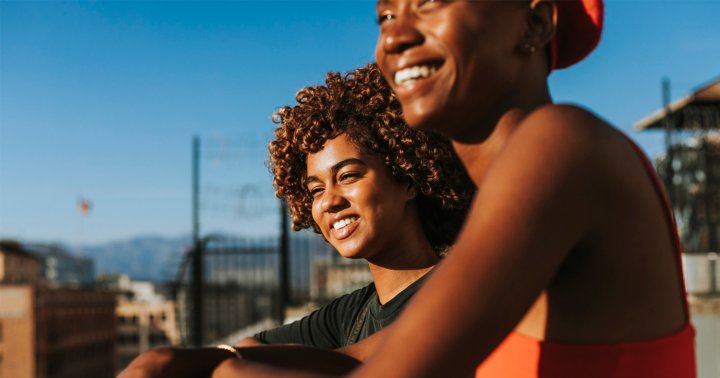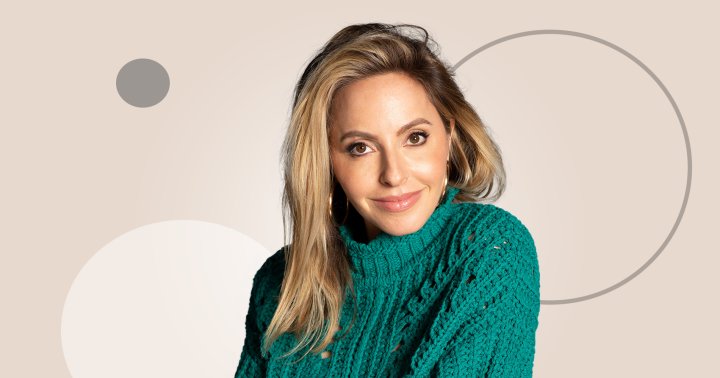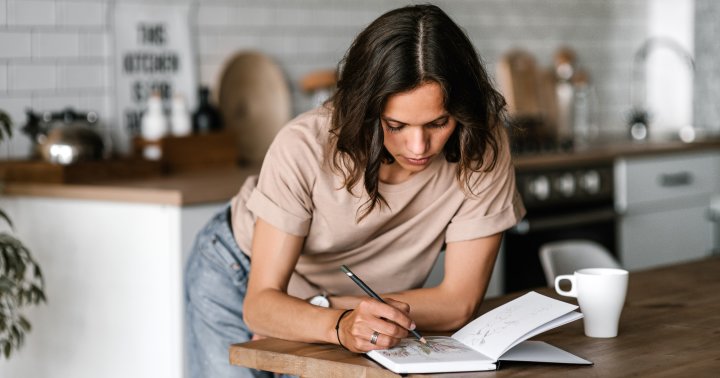Ballroom Dancing: How 3 Steps (and a Tap) Can Change Your Life (Seniors)
“I can’t thank you all enough,” said barrel-chested Dan, 50. He sat criss-cross applesauce on a hardwood linoleum floor, sweat-soaking his t-shirt, looking like a child who just came from playing outside on a sweaty summer day. “I used...

“I can’t thank you all enough,” said barrel-chested Dan, 50. He sat criss-cross applesauce on a hardwood linoleum floor, sweat-soaking his t-shirt, looking like a child who just came from playing outside on a sweaty summer day.
“I used to be a shy, quiet person, but this bachata performance dance team has made a huge impact on me. Thank you all for this life-changing experience.”
I listened to Dan and felt the same: our once a week bachata dance practice had given me an outlet to express myself. Dance had helped me make better choices for my health.
Welcome to ballroom dancing
Dan wasn’t the only one feeling that way. Sitting on the floor criss-cross, reflecting on our season, and munching on veggies and ranch from a veggie tray, Hannah, Martha, and Rick quietly shared how grateful they were to our team for giving them the opportunity to be the best versions of themselves.
“Thank you for making Monday nights so fun, and thank you to all of you who believed in me,” Martha said.
General benefits of dance
The benefits of dance range from:
Making new friends Increased physical fitness Decreased stress Increased self-esteemI’ve been dancing with seniors, adults, college students, and teenagers for more than a decade. But it never ceases to amaze me at how the same footsteps (and occasional tap) that help us live our lives have the power to transform how we view ourselves, others, and the world around us.
Some argue that dance helps people be more physically active and fit. Others mention that dance teams offer them a safe space to express themselves (as was the case with Dan).
Still, others mention that they meet the love of their life on the dance floor. Of those lucky couples, many continue to dance long after their partners pass away.
As I sat on the floor bearing witness to testimonial after testimonial of my Latin dance teammates’ experiences, I couldn’t help but recall my foray into the world of ballroom dancing.
The physical and cognitive benefits of ballroom dancing
I now know that the reason for 50-year-old Dan’s healthy and cheerful disposition lies in good old science.
Harvard University finds that ballroom dances — Zumba in particular — help improve “cognitive skills such as visual recognition and decision-making… [dancing] increases feel-good hormones like serotonin,” and helps our brains develop neural connections needed for “executive functioning, long-term memory, and spatial recognition” (Harvard Medical School, 2015).
Dan wasn’t lying when he said that dance was “life-changing.”
Quite literally, his brain and body were developing new, neuronal connections and boosting important hormones needed to become stronger, more nimble, happier, and healthier — all at the age of 50.
Reading the research was life-changing for me. If Dan could stay healthy at 50 and beyond, I could, too!
The (surprising) mental benefits of ballroom dancing
From April 2023- March 2024, Dan, Hannah, and my teammates and I traveled from Orange County, California to Los Angeles — and as far as Reno, Nevada — to perform our dance routine in front of hundreds of people
After our dance season ended, I couldn’t help but feel I walked away stronger in mind and body. I was curious about what the research said about the mental benefits of ballroom dancing.
I learned that “dancing involves both a mental effort and social interaction… a type of stimulation that can help reduce the risk of dementia” (Harvard Medical School, 2015). I was surprised to hear that moving my feet could help with mental illness.
I credit dance and the principles I’ve learned from it — focus, concentration, practice, dedicated commitment, splendor, and open-mindedness — for helping me stay present and calm while at my job as a marketing copywriter serving senior retirement communities.
The emotional and social benefits of ballroom dancing
After partnering week after week with 50-year-old Martha, 76-year-old Jenny, 21-year-old Blaire, and 38-year-old Tina, I couldn’t help but note how dance had helped me cultivate a new set of friends.
I had gone from watching movies late on the weekends and eating less healthy foods to spending my evenings laughing with great people who shared in my goals to live a joyful, healthy, and active life.
I had built a community of friendly and supportive dance partners.
Tips for ballroom beginners
I get it. Going up to a stranger on a dance floor and asking them to dance can be intimidating.
I’d like to share a couple of tips with you to help get you started on the right foot (and not “two left feet,” as the saying goes) with your ballroom dancing journey.
Take advantage of first-timer free classes: Most dance studios offer free introductory classes — a $10 to $25 value — to help you get to know whether a dance style, studio, and community feels right for you. If the studio doesn’t offer a free class, don’t fret. Let them know it’s your first time, and they’d be happy to work with you to meet your needs!
The internet is your friend: The worldwide web — YouTube and MeetUp.com in particular — has hundreds if not thousands of videos of all different genres of ballroom dancing. A quick search query of “ballroom dance styles” can help you find the right ballroom dance style and studio that matches your needs.
Check out your city’s recreation department and chamber of commerce: your local municipality is well-connected to non-profit organizations, small business enterprises, and other volunteer organizations that can point you in the direction of free indoor and outdoor ballroom social gatherings perfect for any age and preference.
The bottom line
What started as a way to meet new people and stay physically fit soon became a cherished form of self-expression and an opportunity to build community. In short, dance has helped me live healthier in mind, body, heart, and soul.
I wonder what dance can do for you. I’ll see you on the dance floor!
Frequently asked questions (FAQ) about ballroom dancing
Which types of dances constitute ballroom dancing?
Ballroom dancing includes fluid, folk dance forms such as Waltz, Viennese Waltz, Foxtrot, Two-Step, Tango, Polka, Quickstep. More contemporary, rhythmic, and syncopated forms of ballroom dance include Cha-cha, Salsa, Bachata, Cumbia, Pachanga, East and West Coast Swing, Rumba, Samba
Bolero, Country Western, Hustle, Mambo, Jive. Ballroom dance takes place in a room where dancers move in a circular, fluid motion. More contemporary dance styles are danced in a line or in place.
Do I need to have a partner or have experience to go ballroom dancing?
Not in the least! People of all ages go to ballroom dance studios alone and find dance partners with whom to dance. You definitely don’t need to have experience to go ballroom dancing. Some of the most friendly people on the planet are dancers. You’ll find that many dancers don’t have experience in some dance forms, while others have plenty in other dance forms. You’ll be right at home — regardless of age or dance experience.
What are the health benefits of ballroom and social dancing?
Multiple studies have shown that dancing offers a plethora of health benefits to people of all ages, sizes, and abilities. For example, dance requires coordination between a person’s mental, physical, and emotional faculties. Regular dancing can help slow the aging process, improve posture and balance, decrease blood pressure, and improve cardiovascular system functioning.
What makes a good ballroom dance teacher?
Do you prefer a soft-spoken, gentle dance teacher? Or, do you prefer someone who will push you to perform, someone with high energy? Or, do you prefer a dance teacher with both qualities? A “good” ballroom dance teacher is subjective. The best teachers are those who listen to you and guide you in learning the essentials of the dance form. Great teachers also support you in reaching your personal goals.
How do I protect my body while dancing?
As we age, dancing with proper technique becomes ever more important. Stretching 15 minutes before and/or after a class, bending your knees so you’re not dancing on stiff straight legs, and breathing deeply and fully with every move can help you avoid injury so you can dance your entire life. Also, eating healthy foods before and after dancing will ensure your body has the nutrients and energy needed to sustain itself while dancing. Consider reaching out to your primary care physician, physical therapist, doctor, or personal trainer. They can help guide you in making healthy choices for your mind and body for dancing.
Is there etiquette I need to follow with ballroom dancing?
In general, all dancers must respect the rules of consent when dancing. When dancing, it’s considerate to ask the person in a polite and friendly manner, while making eye contact, “Would you like to dance?” If they say yes, lovely! Dance the night away! If they decline, don’t despair! They may be taking a short break. You can thank them and move on to the next partner to ask to dance.
What do I wear when I go social or ballroom dancing?
Generally, your dance attire will depend on the following questions: Where are you dancing (e.g. venue location, indoors or outdoors, and more)? Who are you dancing with (e.g. the age of the dancer, their physical limitations, and style)? Which clothing attire is most comfortable for you to dance in (e.g. do you want to wear shorts, slacks, a button-down t-shirt, or more)? You can’t go wrong wearing casual dressy clothing. Dance attire is a personal choice. It’s really up to you!How can I find a ballroom dance studio near me?
A quick search of “ballroom dance near (insert my location here)” or “social dancing near (insert my location here)” on the internet can give you a list of dance studios, companies, festivals, and dancing clubs where you can find people of all ages, backgrounds, and skills for ballroom dancing. Furthermore, you can also ask friends or family if they know of places to go dancing. In my opinion, word of mouth is the best referral on the planet. If you’re looking for ways to find top-reviewed dance studios, try forum-based websites — like Yelp.com or Nextdoor.com — to find quality reviews of ballroom dance studios in your area.

 JimMin
JimMin 























.jpg&h=630&w=1200&q=100&v=f776164e2b&c=1)







